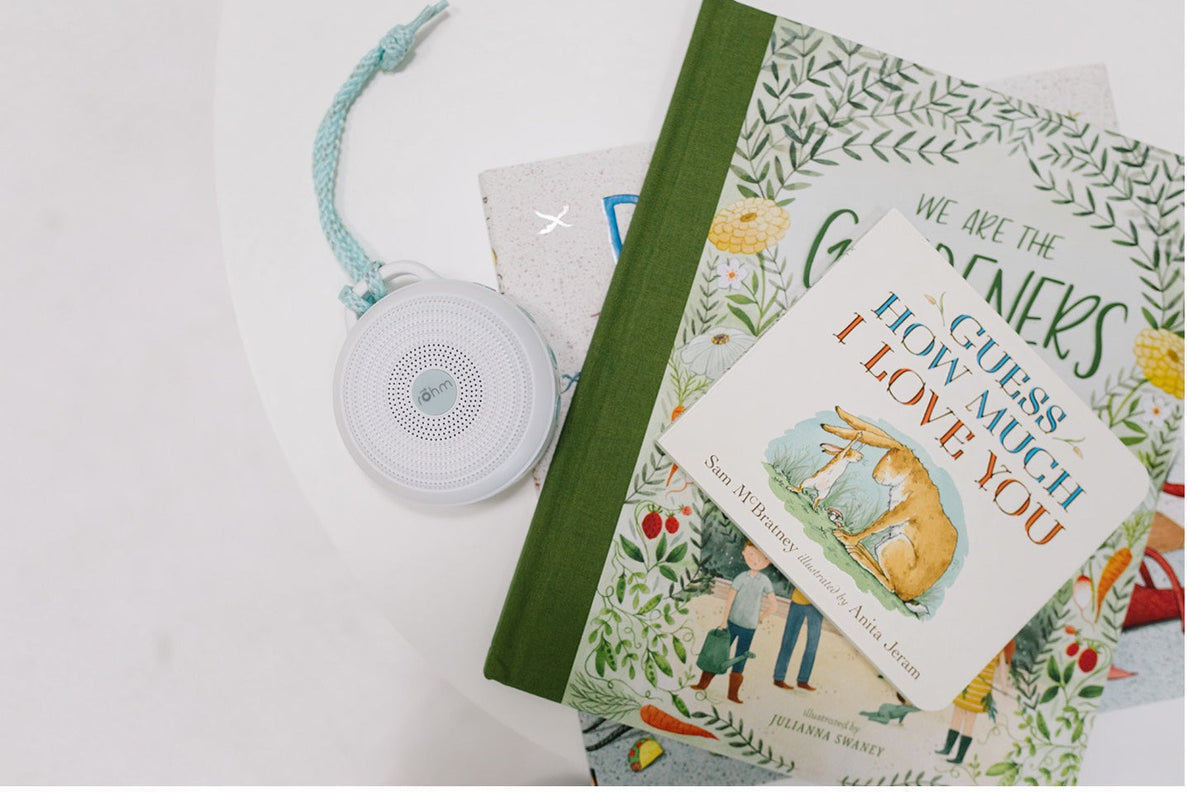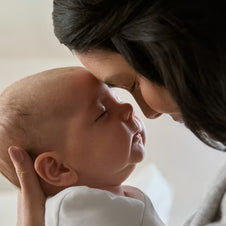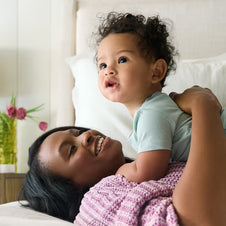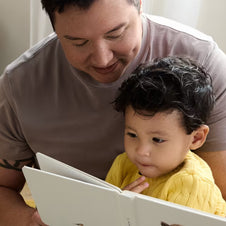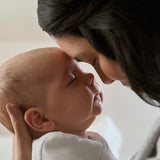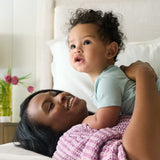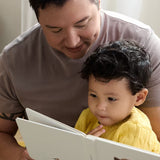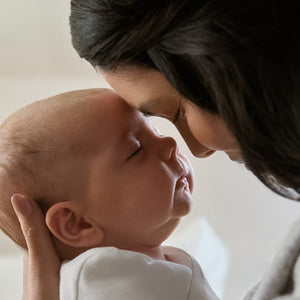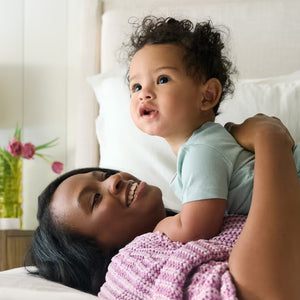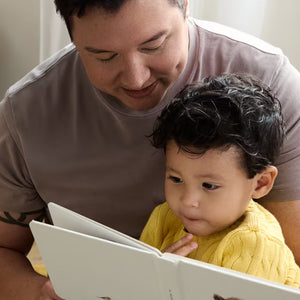This blog covers the most common questions I get about sound machines for babies and toddlers, including the research surrounding white noise, how to use sound machines for newborns, how loud a sound machine should be for babies, safe decibel levels for infants, and more.
Taking Cara Babies Classes
Spoiler Alert: According to the latest AAP statements and research, sound machines help babies and little ones sleep. When used correctly, they are safe.
Why do I love sound machines for baby and toddler sleep?
Sound machines are a great tool for baby and toddler sleep. Research shows us that using a sound machine on a constant setting can:
How do sound machines help with baby sleep?
-
They can be comforting and can make a huge difference in your baby’s sleep.
For babies, especially newborns, silence can feel uncomfortable or bizarre. They simply aren’t used to it because the womb is far from quiet(3). In the womb, your baby sleeps to the sound of a heart beating, blood rushing through the placenta, food digesting (gross, I know), and more. The consistent noise of a sound machine mimics that familiar environment of the womb, which is very comforting for young babies. -
Using a sound machine can prevent environmental noises from disrupting sleep.
Environmental noise is the noise of busy life, especially sounds like transportation, lawn care, technology, etc.. According to the latest statement released by the American Academy of Pediatrics (the AAP)(4), environmental noise is a major cause of disrupted sleep for children, and this disrupted sleep has a negative effect on “daytime alertness, performance, quality of life, and overall health.” Sound machines can help with this concern by masking these environmental noises which, in turn, can make it easier for babies to fall asleep and stay asleep.
Is white noise bad for babies or toddlers? Should I be worried about using a sound machine?
White noise is safe for babies when used appropriately (10,13). There is some research that indicates that if white noise is too loud for too long a period of time it could potentially be harmful (13). But, there is no need to panic and toss your sound machine. If you follow the guidelines, white noise is safe.
Here are the American Academy of Pediatrics’s guidelines for using white noise or a sound machine safely:
-
Place the sound machine at least 7 feet away from your little one’s sleeping space.
-
Use the lowest effective volume. (You can even turn down the volume once your little one is asleep.)
-
Turn off the sound machine during awake time.
When used appropriately, white noise and sound machines are safe for your little ones to use (and research shows that they are beneficial for sleep(4)). You may come across blogs and news articles that declare “sound machines are bad for child development” or that “white noise can lead to hearing loss.” What I want you to know is that I have studied the research, pored over the most recent policy statements of the American Academy of Pediatrics, and have worked extensively with speech-language pathologists and pediatric audiologists regarding the use of sound machines for baby and child sleep.
Let’s talk about these concerns and how the safe use of sound machines prevents any of these issues:
Concern #1: Some people are concerned that sound machines could lead to hearing loss.
What research tells us: Exposure to loud noises for prolonged periods of time can lead to hearing loss(4), which in turn can affect speech and language development. This is a growing concern related primarily to an increase in environmental noise and the use of personal listening devices (think headphones with an iPad). However, there is no evidence that white noise machines, when used following the AAP’s safety guidelines, can lead to hearing loss.
Concern #2: Some people voice fears that sound machines could cause speech delays.
What research tells us: When a child is exposed to loud noises (loud TV, environmental noises, etc) all day long(5), this can affect their speech and language learning simply because they don’t have the opportunity to properly hear adult language throughout the day. In order to prevent this issue with sound machines, we only use sound machines for sleep (at a safe volume) and turn them off during awake time. That way our little ones have sufficient exposure to the adult language that they need to develop language skills.
Concern #3: Some people worry that sound machines might lead to impaired auditory processing. (The way that your brain understands the sounds that you hear.)
What research tells us: There is no evidence that white noise used for sleep has a negative effect on auditory processing. There is a commonly referenced study(6) where rats were exposed to continuous white noise for 24 hours a day, and it’s often misunderstood. We don’t do that. We use white noise for sleep and then expose your little one to language, communication, and natural sounds during awake time. Did you catch that? The study was looking at white noise 24/7, not white noise used for sleep.
Concern #4: Some people worry that sound machines put babies and toddlers into “fight or flight” mode.
What research tells us: “Fight or flight” is the body’s response when it perceives danger or stress. Things like sudden noises or prolonged excessive noises(7)(dropping something in the house, airplanes consistently flying overhead, a car door slamming, bustling traffic outside the window, etc.) can cause our bodies to activate this “fight or flight” response. When you use a sound machine during sleep, you protect your baby or toddler from these sudden loud sounds by creating a safe and consistent sound barrier(4). When used appropriately, there is no indication that sound machines cause this same fight or flight response throughout the night.
Please know that if research said we should stop using sound machines, I would immediately urge parents to stop using them.
I’m constantly looking at the research and listening to experts in the field, and the evidence simply does not indicate that white noise (when used according to the safety guidelines) poses a risk to babies. If you feel concerned, ask your doctor and dig into the research yourself, but at this time, the evidence tells us that sound machines used properly help babies sleep AND are safe.
Thank you for trusting me. I don’t take that responsibility lightly!
Which sound machine setting is best for babies? Should we use white noise, pink noise, brown noise, or a different sound?
When using a sound machine, I recommend that you play a low and deep sound with a continuous hum. This could be green, pink, white, or brown noise, but it could also be the sound of static, shhh, hum, or fan. If you listen and it feels like “ahhhh… that’s nice” that’s the sound we are looking for.
We don't want crickets, music, rainstorms, babbling brooks, or water running as these can be more stimulating and make sleep more difficult.
Fun fact: White noise is all different frequencies combined together equally. Pink noise mutes the high frequencies a bit; brown noise mutes those high frequencies even more, resulting in a much deeper sound, and green noise amplifies mid-range frequencies. You may be surprised to find out that many sound machines machines actually produce pink, green, or brown noise.(12)
Confused yet? The takeaway here is to try the one that’s appealing to you. Any “color” of noise can produce the calming effect we’re looking for. If it sounds calming to you AND it's steady, it’s a good choice!
How loud should my baby’s sound machine or white noise be? What are safe decibel levels for infants?
The American Academy of Pediatrics (AAP)(9) recommends that in hospital nurseries, sound machines are kept at 50 dB or lower. The CDC recommends that a safe decibel level for infants means keeping the volume under 60 dB(14).
We want to use the lowest effective decibel level for your baby’s sleep. The goal is for the white noise to be loud enough to block out extra noises that could wake your baby, without being so loud that it hurts your little one’s ears. Tangibly, this is about the volume of a running shower.
Think about it: If you stand in your shower with the water pouring down over your head, sounds outside of the room won’t disturb you. However, the sound of a shower wouldn’t hurt your ears, and you wouldn’t need to raise your voice to speak with someone just an arm’s length away.
How can I be sure my baby’s sound machine isn’t too loud?
You can test the decibel level by using a decibel meter on your phone (There are many you can download for free; I like this one that is available for iOS or this one.). Simply turn on the sound machine, and place your phone in your little one’s crib to accurately read the decibel level. Keep in mind, decibel-reading apps can be unreliable and inconsistent.
Here’s an easy way to know your sound machine volume is at a safe level: Turn your sound machine on, and go stand next to your child’s sleeping space. While at an arms’ length from another person, can you hold a normal conversation without raising your voice(10)? If so, you nailed it. Your child’s sound machine is at a safe volume.
Expert Tip: Some families have loud households and find that the sound machine at a safe decibel level is not enough to block out those household sounds. I have a hack for you! Place an additional sound machine outside the door of the nursery. The goal is not to create louder “white noise” but rather to create another sound barrier between your baby and the household noise.
How far away should a sound machine be from my baby?
The American Academy of Pediatrics’ (AAP) most current recommendation(9) is that a sound machine should be placed at least 7 feet from your child’s head.
Try placing the sound machine between your child and the source of noise. For example, place the sound machine between the crib and the window to block out outside noises, or if you have twins, place the sound machine between their two cribs.
Now, say you are on-the-go with your little one and want to use your portable sound machine to help with nap time. Most of the time, it’s easiest to hook the sound machine to your baby’s car seat or stroller, which is quite close to their head and doesn’t follow the 7 foot guideline from the AAP. Let’s simply make sure that the volume level is low enough that your baby will be comfortable. And when they wake up from their on-the-go nap, let’s turn off the sound machine!
Safety Note: Make sure the sound machine isn't attached to the car seat handle while driving in the car. You can use the seat belt In the seat next to the car seat and buckle it in so it is secure within the car while driving.
When and how do I stop using a sound machine?
There is no reason to stop using a sound machine for your little one’s sleep. Research shows that using sound machines for sleep has benefits far beyond infancy, even into adulthood.(6) I actually still use a sound machine myself!
However, if you decide that you’d like to stop using a sound machine for your little one’s sleep, you have two options:
-
Weaning. Simply lower the volume on your little one’s sound machine every few nights until it’s so quiet, you can’t hear it anymore. Then, stop using it.
-
Cold Turkey. You can decide one night to stop using the sound machine and see how your little one does through the night! If you find that sleep is negatively impacted, it’s okay to opt for the weaning method.
How do I choose the best sound machine for my baby?
There are few things to keep in mind when choosing your sound machine. Look for a sound machine that has:
-
Continuous noise: Look for a sound machine with continuous sound rather than one with a timer that turns the sound machine off. (This disruption in the noise can cause your baby to wake.)
-
White noise: Look for a sound machine with continuous white, pink, or brown noise. (For some babies and toddlers, more varying sounds like ocean waves or rain storms can be disruptive to sleep.)
-
No extra lights: Look for a sound machine without lights or with lights that can be turned off. (Light is very stimulating(12) for the infant brain and makes it difficult for little ones to fall asleep and stay asleep.)
-
Extra features that you like: Some sound machines offer extra features like a nightlight or ok-to-wake clock. This can be helpful for middle-of-the-night diaper changes with a newborn or during the toddler years.
My personal favorite sound machine: The Yoga Sleep series (Code CARA20 gets you 20% off)
These sound machines are easy-to-use and produce a few soothing sound options. The Hushh and Rohm can be plugged in or used with battery power, making it convenient for home, travel, and naps-on-the-go. They also don’t require an app or WiFi connection.
Other popular sound machines from the Taking Cara Babies community are all linked here for you.
If you need more sleep help, I’m here for you. Whether you have a newborn (0-4 months), baby (5-24 months), or toddler (2-4 years), I can walk you step-by-step through an evidence-based and emotionally-connected approach to establishing great sleep.

